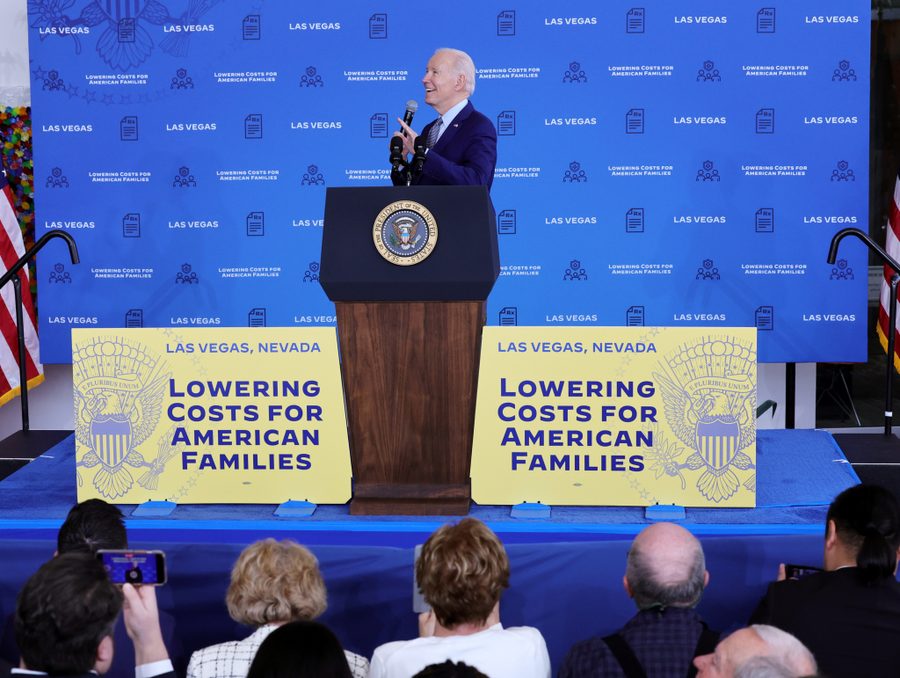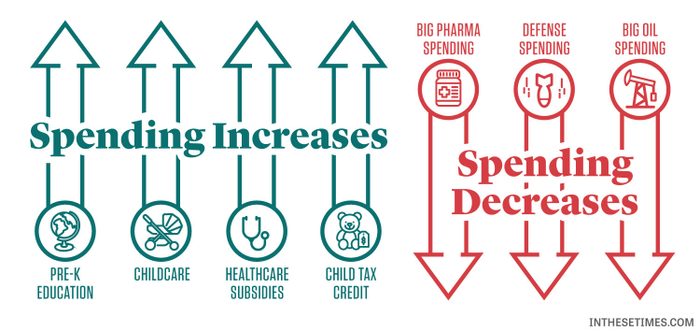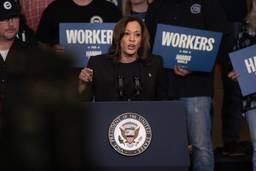Biden’s New Budget Is a Progressive Opening Gambit
While Republicans are proposing to slash social programs, the White House has released a plan to boost policies that help working families while increasing taxes on the rich and corporations.
Max B. Sawicky

When members of the Biden administration sat down to compose their federal budget proposal for Fiscal Year 2024, they faced some confounding problems. The economic situation in the United States is dogged by inflation fears, with an out-of-control Federal Reserve playing whack-a-mole with employment growth. The war in Ukraine, a source of global disruption in commodities and of general market instability, shows no signs of winding down. And the new Republican leadership in the U.S. House of Representatives, which controls the gates through which a budget must pass, is made up of certifiable kooks.
Earlier this month, the president released his budget — simultaneously a progressive policy vision and a statement of contrast with the Republicans’ budget plans. Since the Democrats must negotiate with the Republican-led House, Biden’s proposed budget is really just an opening bid. Nobody expects it to be enacted.
In simplest terms, the Democrats would bring about an expansion of social programs financed by higher taxes on corporations and the wealthy. The headlines that the Biden administration likely wanted for its proposals are: a big decrease in the public debt, tax cuts for the middle class and reductions in Medicare spending through reductions in the prices of prescription drugs.
Meanwhile, the Republicans, under the pretext of addressing the public debt — a commitment they have proven time and again they do not genuinely uphold — propose cuts in domestic spending.
Evaluating a budget must include its interplay with the economy. On the latter score, the United States has experienced very rapid job growth. It’s possible to exaggerate the significance of this increase because we are coming off the lows caused by the pandemic. It’s easier for the U.S. economy to grow from the deepest part of a recession. Still, growth beats the hell out of not growing, and by general consent, federal deficit-financed spending since 2020 — mostly urged on by Biden and the Democrats — deserves the credit. Unemployment rates are at record lows.
This job growth has coincided with an elevation of the price level, i.e. inflation, though the major increases in prices of goods like gas largely ended around the middle of 2022. In other words, prices have not returned to their pre-pandemic levels, but they did stop increasing as rapidly. Looking forward, inflation is thought by some to be around 5%, by others less. The Federal Reserve thinks that rate must be shrunk to 2%, and the only hammer they have to beat down this nail is interest rate increases intended to reduce employment and wages.
No one doubts that at some point interest rate increases will have the effect of throwing millions of Americans out of work. But the resilience of the labor market in the face of the steepest and most rapid rate increases in many years suggests that something other than demand is driving price increases. Getting inflation down may not, under present circumstances, be within the Fed’s power.
The Republicans have been making hay over the elevation in prices, failing to note that the biggest increases stopped nearly a year ago. Even more absurdly, they have largely escaped criticism for floating a proposal for a national sales tax of 30%, despite the fact that anyone with a spoonful of economics knows a sales tax will increase prices by the same rate as the tax. Inflation since 2020 has always been well under 10%, but a 30% price hike is somehow different, and desirable?
One of the Democrats’ chronic deficiencies is their refusal to criticize the Fed’s conduct of monetary policy. Biden has appointed Fed leaders, but there is no indication that any of his choices are doing anything to moderate the Fed’s war on job growth.
The president’s budget presentation returns to the time-honored crutch of proposing to fix the public debt. When it comes to that pastime, much like his tax-cut schtick, the president’s proposals are fundamentally defensive. A progressive approach to the debt would highlight the benefits of new domestic spending, along with cuts in the grossly excessive outlays for defense, and not obsess over “pay-fors.” Spending in Biden’s proposed budget does not increase as a share of GDP. It is not an activist budget.
How big a worry is the debt? Ever since the 1980s, we have been told that federal debt is unsustainable and will crush the economy. Somehow, we have survived. Even so, the president’s budget would have debt grow more slowly than the economy.
Of course, the Republicans’ business model is to not be satisfied with anything Democrats do. A new angle in their advocacy is to flirt more openly with the third rail of fiscal policy — willingness to cut Social Security and Medicare. Their added leverage at this point is the ability to block increases in the debt ceiling. At some point later this year the federal government will need to increase borrowing and break through the current debt limit in order to continue paying interest on outstanding debt, among other mandatory payment obligations. If Congress does not approve such an increase, that would lead to debt default with unpredictable, global financial consequences. Whether Republicans will actually force such a crisis remains to be seen.
There is new money in Biden’s budget for pre-K, child care, Obamacare subsidies, and the Child Tax Credit, among other items. Cuts in healthcare costs would extend the duration of Medicare trust fund balances. There are also modest cuts in defense. The net increases in non-defense spending are offset by tax increases on corporations and on the wealthy, from which the vast majority of U.S. families will be shielded. The result is a net reduction in budget deficits and the federal debt.

In the absence of any relief from the Fed’s campaign to cram down jobs and wages, the most salient elements of the president’s proposal are sources of relief for the lowest-income families. The expanded Child Tax Credit in particular has been shown to have large effects in reducing poverty for families with children. Also noteworthy is the administration’s commitment to passing paid family and medical leave.
Given the state of divided government, as noted above, Biden’s budget is more of a wish list than a politically realistic set of policies. The Republican House will try to claw back the tax and spending increases without being specific on exactly how they would pursue their purported goal of debt reduction.
The secret here is that nobody really cares about the debt, except a few Democrats in red districts and states who want to distinguish themselves from their party. The Republicans may hint at attacking Social Security, but ultimately their nerve will likely fail. The same goes for opposing cuts in drug prices. And their dirty secret is that they actually like infrastructure spending. The big lobbying money will focus on defending corporations and the wealthy from tax increases. It’s the same old game.
As a messaging exercise, the administration’s budget has scratched the itches of its major constituents. AFSCME President Lee Saunders described it as “a bold plan to invest in working families.” Congressional Progressive Caucus Chair Pramila Jayapal (D-Wash.), meanwhile, said “This budget would advance priorities progressives have been pushing for years.” In this respect it is a good mainstream Democratic message, rather than a lurch to the center.
Both parties are clarifying their postures, but the division of government and the Democrats’ thin majority in the Senate suggest that little will change in either direction this year. Advances in progressive economic policy — and the future of U.S. democracy — will depend on the outcome of the 2024 elections.
Max B. Sawicky is an economist and writer in Virginia, formerly with the Government Accountability Office and the Economic Policy Institute. He is a Senior Research Fellow at the Center for Economic and Policy Research and runs the MaxSpeak, You Listen! blog at sawicky.substack.com.








